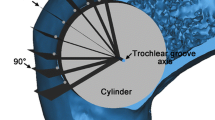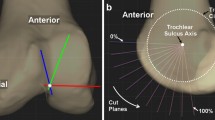Abstract
Photography was used to study the geometry of the cartilaginous and osseous contours of the distal femur and the orientation of the trochlear groove in 9 fresh-frozen and 24 embalmed knees. The sulcus angle (146.1°±5.5°) decreased from 0° to 50° of femoral flexion then increased afterwards. The maximum slope of the lateral femoral condyle (20.2°±5.2°) also decreased with flexion. Both the sulcus angle (p =0.0007) and maximum slope (p =0.0001) were larger at 0° than they were for 60° cartilaginous surfaces. The lateral femoral condylar height decreased, whilst the medial femoral condylar height increased as the flexion increased. The femoral groove was midway between the two femoral epicondyles (49.5±3.9%), but deviated laterally as the flexion angle increased. The groove axis deviated distally and laterally from the femoral anatomical axis for both cartilaginous and bony surfaces, and the angle between the groove and anatomical axes was similar for both cartilaginous (19.1°) and osseous (16.8°) surfaces. Articular cartilage is not well represented on radiography yet it had a significant effect on the distal femoral geometry, and should be taken into account when evaluating the patellofemoral joint.









Similar content being viewed by others
References
Ahmed AM, Duncan NA, Tanzer M (1999) In vitro measurement of the tracking pattern of the human patella. J Biomech Eng 121:222–228
Berger RA, Rubash HE, Seel MJ, Thompson WH, Crossett LS (1993) Determining the rotational alignment of the femoral component in total knee arthroplasty using the epicondylar axis. Clin Orthop 286:40–47
Brattstrom H (1964) Shape of the intercondylar groove normally and in recurrent dislocation of patella. A clinical and X-ray-anatomical investigation. Acta Orthop Scand Suppl 68:1–148
Brossmann J, Muhle C, Schroder C, Melchert UH, Bull CC, Spielmann RP, Heller M (1993) Patellar tracking patterns during active and passive knee extension: evaluation with motion-triggered cine MR imaging. Radiology 187:205–212
Bull AMJ, Katchburian MV, Shih Y-F, Amis AA (2002) Standardisation of the description of patellofemoral motion and comparison between techniques. Knee Surg Sports Traumatol Arthrosc 10:184–193.
Carson WG Jr, James SL, Larson RL, Singer KM, Winternitz WW (1984) Patellofemoral disorders: physical and radiographic evaluation. Part II: Radiographic examination. Clin Orthop 185:178–186
Dejour H, Walch G, Nove-Josserand L, Guier C (1994) Factors of patellar instability: an anatomic radiographic study. Knee Surg Sports Traumatol Arthrosc 2:19–26
Eckhoff DG, Burke BJ, Dwyer TF, Pring ME, Spitzer VM, VanGerwen DP (1996) Sulcus morphology of the distal femur. Clin Orthop 331:23–28
Eckhoff DG, Montgomery WK, Stamm ER, Kilcoyne RF (1996) Location of the femoral sulcus in the osteoarthritic knee. J Arthroplasty 11:163–165
Feinstein WK, Noble PC, Kamaric E, Tullos HS (1996) Anatomic alignment of the patellar groove. Clin Orthop 331:64–73
Goh JC, Lee PY, Bose K (1995) A cadaver study of the function of the oblique part of vastus medialis. J Bone Joint Surg Br 77:225–231
Griffin FM, Math K, Scuderi GR, Insall JN and Poilvache PL (2000) Anatomy of the epicondyles of the distal femur: MRI analysis of normal knees. J Arthroplasty 15:354–359
Harper WM, McCaskie AW, Harding ML, Finlay DBL (1995) Anterior knee pain: the use of computerized tomography to assess the results of tibial tubercle transfer. Knee 2:207–210
Heegaard J, Leyvraz PF, Curnier A, Rakotomanana L, Huiskes R (1995) The biomechanics of the human patella during passive knee flexion. J Biomech 28:1265–1279
Hollister AM, Jatana S, Singh AK, Sullivan WW, Lupichuk AG (1993) The axes of rotation of the knee. Clin Orthop 290:259–268
Hsu HC, Luo ZP, Rand JA, An KN (1997) Influence of lateral release on patellar tracking and patellofemoral contact characteristics after total knee arthroplasty. J Arthroplasty 12:74–83
Koh TJ, Grabiner MD, De Swart RJ (1992) In vivo tracking of the human patella. J Biomech 25:637–643
Koskinen SK, Kujala UM (1992) Patellofemoral relationships and distal insertion of the vastus medialis muscle: a magnetic resonance imaging study in nonsymptomatic subjects and in patients with patellar dislocation. Arthroscopy 8:465–468
Koskinen SK, Taimela S, Nelimarkka O, Komu ME, Kujala UM (1993) Magnetic resonance imaging of patellofemoral relationships. Skeletal Radiol 22:403–410
Kujala UM, Osterman K, Kormano MJ, Komu ME, Schlenzka D (1989) Patellar motion analyzed by magnetic resonance imaging. Acta Orthop Scand 60:13–16
Kwak SD, Ahmad CS, Gardner TR, Wu H, Grelsamer RP, Henry JH, Blankevoort L, Ateshian GA, Mow VC (1996) The iliotibial band has a small but significant effect on knee kinematics and articular contact. Trans Orthop Res Soc 21:718
Lafortune MA (1984) The use of intra-cortical pins to measure the motion of the knee joint during walking. Thesis, Pennsylvania State University
Laurin CA, Dussault R, Levesque HP (1979) The tangential X-ray investigation of the patellofemoral joint: X-ray technique, diagnostic criteria and their interpretation. Clin Orthop 144:16–26
Mantas JP, Bloebaum RD, Skedros JG, Hofmann AA (1992) Implications of reference axes used for rotational alignment of the femoral component in primary and revision knee arthroplasty. J Arthroplasty 7:531–535
Minkoff J, Fein L (1989) The role of radiography in the evaluation and treatment of common anarthrotic disorders of the patellofemoral joint. Clin Sports Med 8:203–260
Nagamine R, Otani T, White SE, McCarthy DS, Whiteside LA (1995) Patellar tracking measurement in the normal knee. J Orthop Res 13:115–122
Perrild C, Hejgaard N, Rosenklint A (1982) Chondromalacia patellae: a radiographic study of the femoropatellar joint. Acta Orthop Scand 53:131–134
Pinar H, Akseki D, Genc I, Karaoglan O (1994) Kinematic and dynamic axial computerized tomography of the normal patellofemoral joint. Knee Surg Sports Traumatol Arthrosc 2:27–30
Pinar H, Akseki D, Karaoglan O, Genc I (1994) Kinematic and dynamic axial computed tomography of the patello-femoral joint in patients with anterior knee pain. Knee Surg Sports Traumatol Arthrosc 2:170–173
Poilvache PL, Insall JN, Scuderi GR, Font RD (1996) Rotational landmarks and sizing of the distal femur in total knee arthroplasty. Clin Orthop 331:35–46
Portney LG, Watkins MP (1993) Foundations of clinical research. Applications to practice. Appleton & Lange, Norwalk
Reider B, Marshall JL, Ring B (1981) Patellar tracking. Clin Orthop 157:143–148
Sakai N, Luo ZP, Rand, JA, An KN (1996) Quadriceps forces and patellar motion in the anatomical model of the patellofemoral joint. Knee 3:1–7
Schutzer SF, Ramsby GR, Fulkerson JP (1986) The evaluation of patellofemoral pain using computerized tomography. A preliminary study. Clin Orthop 204:286–293
Sheehan FT, Zajac FE, Drace JE (1999) In vivo tracking of the human patella using cine phase contrast magnetic resonance imaging. J Biomech Eng 121:650–656
Siu D, Rudan J, Wevers HW, Griffiths P (1996) Femoral articular shape and geometry. A three-dimensional computerized analysis of the knee. J Arthroplasty 11:166–173
Staubli HU, Durrenmatt U, Porcellini B, Rauschning W (1999) Anatomy and surface geometry of the patellofemoral joint in the axial plane. J Bone Joint Surg Br 81:452–458
Tennant S, Williams A, Vedi V, Kinmont C, Gedroyc W, Hunt DM (2001) Patello-femoral tracking in the weight-bearing knee: a study of asymptomatic volunteers utilising dynamic magnetic resonance imaging: a preliminary report. Knee Surg Sports Traumatol Arthrosc 9:155–162
Vaara P, Marttinen E, Peltonen J (1997) Ultrasonography of the patellofemoral joint in diastrophic dysplasia. J Pediatr Orthop 17:512–515
Vahasarja V, Lanning P, Kinnunen P, Serlo W (1995) Technical report: radiological evaluation of patellar malalignment using a new frame for axial imaging of the patellae. Clin Radiol 50:56–58
Vahasarja V, Lanning P, Lahde S, Serlo W (1996) Axial radiography or CT in the measurement of patellofemoral malalignment indices in children and adolescents? Clin Radiol 51:639–643
Wiberg G (1941) Roentgenographic and anatomic studies on the femoropatellar joint. Acta Orthop Scand 12:319–410
Yoshioka Y, Siu D, Cooke TD (1987) The anatomy and functional axes of the femur. J Bone Joint Surg Am 69:873–880
Acknowledgements
Y.-F.S. was supported by a scholarship from the Ministry of Education, Taiwan. A.M.J.B. is supported by the Arthritis Research Campaign. We also thank Dr. D. Watt and Dr. M. Guan of the Anatomy Facility at Charing Cross Hospital, Imperial College School of Medicine for their help.
Author information
Authors and Affiliations
Corresponding author
Rights and permissions
About this article
Cite this article
Shih, YF., Bull, A.M.J. & Amis, A.A. The cartilaginous and osseous geometry of the femoral trochlear groove. Knee Surg Sports Traumatol Arthrosc 12, 300–306 (2004). https://doi.org/10.1007/s00167-003-0414-3
Received:
Accepted:
Published:
Issue Date:
DOI: https://doi.org/10.1007/s00167-003-0414-3




